No, I’m Not a Human review
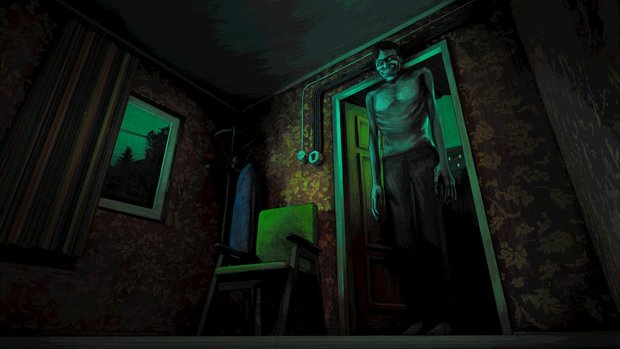
- 0 Comments
You wouldn’t want to live there, but this uniquely grim, brutal cosmic horror sure is a nice place to visit
We all have subconscious biases when we interact with the people around us. It’s an uncomfortable aspect of what makes us human; logically we know these are kneejerk assumptions based on little more than a quick glance at someone we know little to nothing else about, and often we discover our initial reactions were wildly off base once we get to know them better. No, I’m not a Human masterfully plays on our primal tendency to judge those we meet purely by (potentially) inconsequential traits, as here it can lead to life-or-death scenarios in a world gone mad. It’s a little too easy to game the system once you have met the same individuals across multiple playthroughs, but taken as a single experience, it is an intense thriller where choices impact an impressive array of endings based on the decisions you make at the end of the world.
You play as a nameless homeowner living alone in a small house at the edge of town. A solar anomaly has caused the sun to shoot out dangerous levels of energy during the daytime that will set fire to anyone unlucky enough to be caught in its rays (and setting fire to forests and countrysides, where vast expanses of vegetation have been completely wiped out). Humanity can now exist outside the safety of their dwellings only during the dark of night, but wandering in the shadows is a threat unlike anything we’ve ever seen before: the Visitors.
These creatures crawled up from beneath the planet’s surface, and little is known about who or what they are – other than the fact that they look and talk exactly like humans. Except… they aren’t human, and if a Visitor catches someone alone, they won’t hesitate to brutally murder them for no apparent reason. This is the nightmarish reality you find yourself trying to survive in, and as the world continues to descend into chaos, you must work together with the pockets of fellow survivors who come to your house seeking shelter. To do that, though, you must determine who is telling the truth and who is trying to gain your trust just long enough to slit your throat when you least expect it.
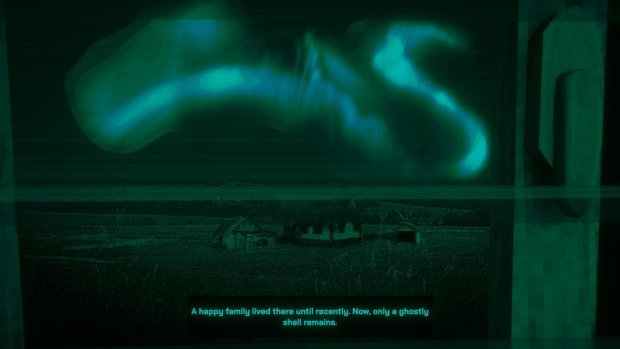
To say No, I’m not a Human’s setting is bleak is an understatement. The entire game occurs inside your home, and each in-game day that passes sees the world fall further into madness. Explored in first person with WASD and mouse controls or gamepad, the house interior is rendered in a grainy low-poly, low-resolution graphical style that aligns with a time period implied to take place at the turn of the millennium. You watch the news on a large chunky CRT TV set, while there is a single landline phone and sticky notes of various phone numbers on a wall rather than in an electronic directory.
While wandering through the hallways you can open any door into various rooms and interact with objects like the shuttered windows to look outside. You can’t freely move around these rooms, but each one is packed with small details that make it feel like a lived-in space. The living room has a small lucky cat figure on a shelf, and the kitchen sports a sparsely stocked fridge with a single jar of pickles and various perishable items that slowly go bad as the game progresses. Unlike the freely maneuverable sections, these scenes are explored through a simple point-and-click interface where you click on certain objects and individuals that become highlighted when moused over.
Both indoor and outdoor spaces are portrayed in a unique visual style that blends lifelike images with more obviously (and often grossly twisted) hand-drawn artwork. Your neighbor’s house looks like it could be a real photo set against a grassy plain, but seen through your window it is difficult to tell where the real elements end and the drawings begin. Peering through the peephole of your front door, you’ll see various buildings in the nearby city that look equally photorealistic and yet intentionally pixelated. It’s a striking aesthetic, and when combined with the greenish hue that washes over everything once night falls, it is an artistic vision all its own.
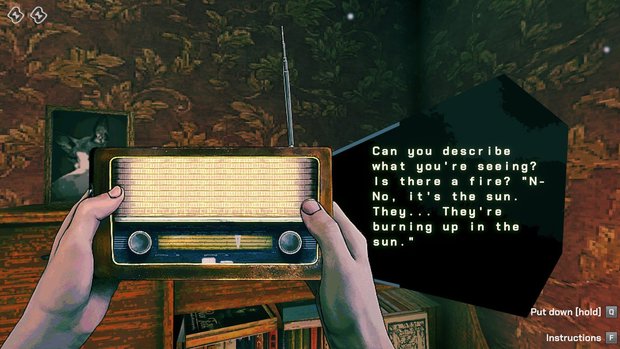
But nowhere is the unique look of No, I’m not a Human more apparent than in its human/inhuman inhabitants. Every character incorporates bodily distortions and various misproportions that make them intentionally off-putting. This can be rather disturbing: one character appears to have eyes bigger than their face due to their glasses extending beyond the sides of their cheekbones, another is covered in burns with exposed teeth, while still another has an entire half of their face sagging downwards. Every model feels off – which matters because hidden amongst the bizarre-looking humans you meet is something even more terrifying: the Visitors.
The Visitors want to kill you and every other person on Earth. They look and sound human, and other than a few unremarkable traits there’s absolutely no way to tell them apart from those who are just trying to survive. Each night your house will get a set number of characters knocking at your front door looking for a place to stay. These individuals are randomized from a large pool of potential characters, and all have unique personalities that make interactions with them feel like genuine conversations. But at the same time, there’s a sort of stifling uncertainty around every bit of dialogue that feels both natural and unsettling. Everyone is uneasy with the world falling into chaos, so people will act distant, desperate, or completely unhinged – all of which would normally come off as red flags but are way harder to judge when everything has gone to hell and no one is acting rationally.
This makes it even harder to perform your main goal in No, I’m not a Human – namely, to decide who actually is a human worthy of helping and who is a Visitor masquerading as one. Whenever you complete a conversation with an individual at your doorstep, you are given the option to invite them in or tell them to leave. Typically it is impossible to determine if someone is a Visitor or not based solely off this one exchange, so a lot of early choices are determined by luck rather than informed decisions. You may think the easy option here is to turn everyone away to avoid the possibility of them being a Visitor, but that leads to one of the special encounters you can come up against.
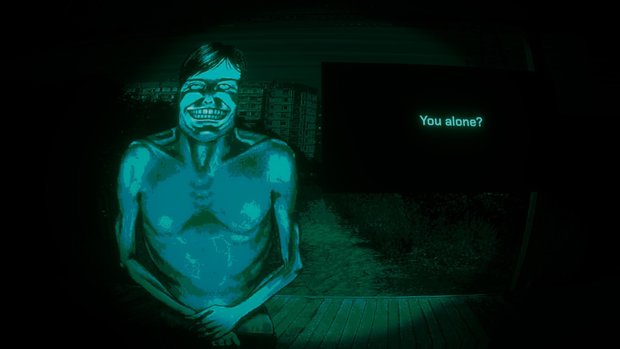
Every few nights, you will be met at the door by a strangely tall, shirtless man with an unnerving grin on his face. He speaks as though he knows more about what’s going on than you or anyone else, and at the end of each conversation he will ask if you are alone. If you answer “Yes,” he will walk inside… and that’ll be the end of you. If you answer “No” and you do have others in your house, then he will walk away and leave you to your own devices for the time being. As the game progresses, you will have to deal with additional factors when facing the smiling man, such as the number of Visitors you have in your home that you have not dealt with (limited by the set number of tests you can run per day to determine who is a Visitor and who isn’t – more on that later). Other special encounters include an agent from the newly formed Federal Emergency Management Agency (FEMA), who will take a person at random from your house to conduct their own tests for signs of being a Visitor (and never returned), or a strange bald man who tells you of various prophecies he sees from beyond the veil before walking away without a word.
There are quite a few minor typos that are never egregious enough to break the suspension of disbelief, but are common enough to be noticeable. All dialogue is provided exclusively through text, but there are small bits of voice samples used throughout, like garbled voices on a radio or someone crying behind a door. This is combined with a masterfully surreal soundtrack that is largely muted with quiet synthetic sounds, but swells into emotional pieces that bring together solo guitar and bits of piano melody. The music complements the sad yet unsettling ambience of No, I’m not a Human beautifully, blending together the macabre with the harsh realities of survival in a dying world.
The interactions at your front door take place at night, when the sun’s burning rays are weak enough that you can look outside safely. During the day, you have a set number of energy points that dictate the actions you can take before you are exhausted by the heat and need to sleep until evening. These actions are typically used for one purpose: to test the people in your home (and possibly even yourself) for signs of being a Visitor. Each morning you awaken to an emergency news broadcast that gives some idea of what is going on outside. At the end of the broadcast, you will learn the latest indicator that suggests someone might be a Visitor. Unfortunately, these are usually fairly mundane traits: perfect teeth, bloodshot eyes, and shaved armpits all being examples.
Physical signs of being a Visitor are too subtle to be observed without a test. Each trait has to be tested separately, and each test takes up an energy point. With only a couple points available each day, these have to be used very carefully. There’s no real puzzling involved in administering a test, as they’re simple pass or fail checks. And yet even after testing positive for one characteristic, it’s entirely possible that person is not a Visitor. They might have perfect teeth because they just went to the dentist, or maybe they have bloodshot eyes because they’re a stoner. In most cases, you are making educated guesses rather than full deductions on who is and who isn’t a Visitor – it’s an intentional design choice to keep up your paranoia.
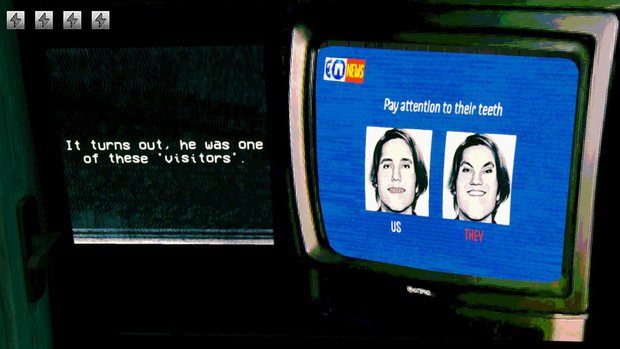
Anyone you have let into your home can be found in the different rooms of your house, and during the day you can talk with them to learn more about what happened before arriving here. Chatting with people doesn’t take energy, unlike running tests. The brutal stories that brought people here serve as harsh reminders of the world outside the relative safety of your home: one person has gouged out their own eyes after witnessing something unspeakable, and another carries the body of her dead husband, refusing to let him go. There are some genuinely shocking moments with the characters you meet – each of them left nameless, going only by titles like the “sad girl” or “your neighbor.” This effectively alienates you further from these people, reinforcing the uncertainty that any one of them could wind up being a Visitor lying to you.
Some characters have incredibly dense storylines that can be uncovered through multiple days of in-game time, but if they’re unlucky enough to be taken away by FEMA or chosen by a Visitor as their evening kill, then your story with that individual is cut short. If that happens, there is no response from the protagonist. One person even spent the night with me in my room, and when I found them dead after a round of Visitor roulette, there wasn’t even the slightest reaction from my character to the mangled corpse having been shoved into bags for me to find.
Living alone before the apocalypse, you have a shotgun handy and can use it after running a test to “deal” with anyone you feel is not human. Once you take out the gun, there is an option to hear the person out to see what else they have to say. But if you decide to pull the trigger, that’s the end of it. If the person you killed was a Visitor, the body will be depicted as a blurred image of pulsating flesh to let you know you were right. If the person you killed was a human, you’ll be left with a trash bag filled with a tragic victim of your misjudgment. If a Visitor is left in your house until the following morning after being let inside, they will kill one of the other inhabitants in your house and leave you with the remains bagged up and left for you to find where they once stood.
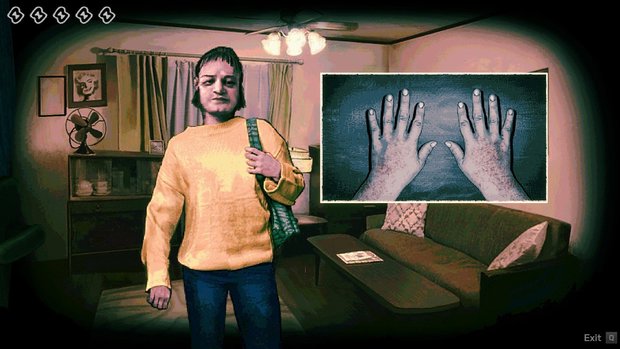
The game strikes a generally fine balance of conversing with survivors and weeding out Visitors while dealing with the omnipresent threats of FEMA taking your people away, Visitors killing folks in your home, or the smiling man finding you on a night when the house is empty. Unfortunately, the cracks start to show the further into the experience you go. I never had a Visitor that attempted to kill me specifically, which seemed a bit bizarre when they are supposed to kill indiscriminately. The lack of agency when characters are killed is also frequently frustrating – some tasks require specific individuals to survive in order to have a particular storyline move forward, and even a single unfortunate random event can lead to entire quest lines being blocked off for that playthrough.
There are some ways of lessoning the randomness through a small number of FEMA pamphlets you receive, though these are few and far between. If you have two characters in your house and you want to increase the chances that one of them is taken instead of the other (in case you need them for a specific task you’re working to complete), then you can give the expendable character a pamphlet to have them be chosen by the next FEMA agent instead. Being able to prioritize certain characters over others in this way can be a godsend, and yet there’s still no guarantee that the character you’re trying to protect won’t be killed by a Visitor instead.
Thanks to a post-launch update, your progress is now able to be saved upon quitting to the desktop, but possessing kombucha allows you to perform a manual save that you can reload if you end up dying or getting an ending you don't like. You start with a single jar of kombucha, but there are rare opportunities to acquire more from people you meet if you are lucky enough, though be forewarned that each uses the same save file. Unfortunately, if you save after a key character is killed from a specific quest line, then you are only able to reload from that point and are shut out from continuing the desired story without restarting the game completely from the beginning. So with just the one save file, you have to be vigilant with where and when you record your progress. Fortunately, your latest kombucha save will remain even after reaching an ending to the current storyline.
This save system, while appearing minimal, is actually easy to abuse once you have a manual save located at a point in the story that is not yet locked into any set ending path. While it is impossible to tell a Visitor apart from a human at first glance, this is an issue if you are visited by the same one in a subsequent replay. Characters who visit your home each night are randomly chosen, but if someone is a Visitor, they are always going to be a Visitor. So if you successfully find out someone is a Visitor before you arrive at one conclusion, then if you reload the game and see the same individual again, they will still be a Visitor. While I understand it is a ton of work to write each character and maintain a feeling of mistrust, it’s unfortunate that you can start to cheese the game by either refusing entry to known Visitors or allow them inside only to immediately shoot them without having to run extensive tests.
There are ten different endings in No, I’m not a Human, many of which require a specific set of individuals to survive or other various parameters to be met. While it’s easy to arrive at an ending, it gets significantly more complicated if you’re trying to see a specific outcome. One ending requires you to keep a group of cultists alive long enough to complete an unspeakable ritual, while another demands that you perform various tasks that lead to unearthing a dark secret deep beneath your home.
In a game that’s only around three hours long, it’s quite the feat that there are so many ways the story can conclude. I personally found four completely different endings after reloading to my last manual save and playing through to the conclusion. Each finale is shown in a hand-drawn visual style that looks different from any other part of the game, and they’re all gorgeously depicted with simple yet effective still shots. While I found all the outcomes to be satisfying in their own right, surprisingly none of them offer any explanations beyond loose hints as to what the Visitors are and where they came from. Some players will undoubtedly be disappointed by the lack of concrete answers, but I found it fitting that a game about paranoia and confusion ends without fully providing a complete picture.
Final Verdict
No, I’m not a Human is like the cosmic horror Papers, Please I didn’t know I needed in my life. It’s a unique horror adventure in which simply answering a knock at the door becomes a roulette of death, where humans and monsters are far more dangerous than bullets. The game has a genuinely unsettling atmosphere all its own, and going in blind I found it unlike anything else I have ever played. Instead of the randomness of who is killed or taken, potentially against my will, I’d have preferred there to be more arbitrary elements in who is actually a Visitor. This would allow for more surprises when trying to see the various alternate story outcomes. The endings are all vastly different from each other and are worth the time to pursue, even if that means going back and replaying the game (or parts of the game) two or more times. Repeat playthroughs become a bit easier to rig in your favor, but long before that happens, this game will undoubtedly get under your skin.
Hot take
No, I’m not a Human is a masterclass in suspense that revels in the paranoia it creates. Some of the magic is lost when trying to unearth specific outcomes for this tale of cosmic horror, but for a single playthrough it’s a deeply disturbing experience where everyday traits of average people are twisted into a mine field.
Pros
- Incredible atmosphere backed by a haunting musical score
- Deeply disturbing subject matter doesn’t pull punches
- Beautiful presentation purposefully immersed in the uncanny valley
- Impressive number of outcomes that adapt to player choices
Cons
- Lack of agency in random gameplay elements
- Emotional detachment from other characters is a double-edged sword
- Identifying Visitors can impact subsequent playthroughs
- Minor typos throughout
Sam played No, I’m not a Human review on PC using a review code provided by the game's publisher.


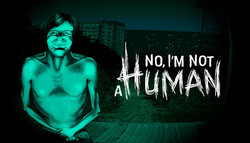

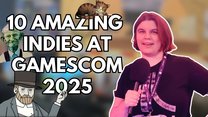

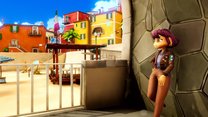

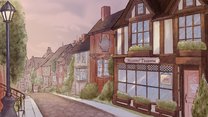

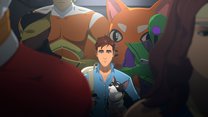
0 Comments
Want to join the discussion? Leave a comment as guest, sign in or register.
Leave a comment